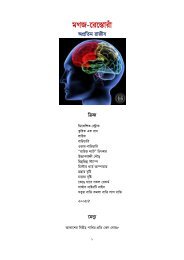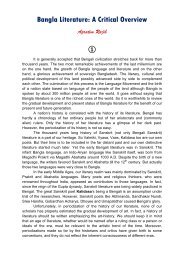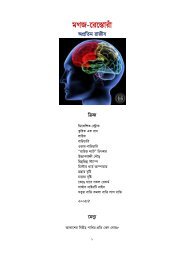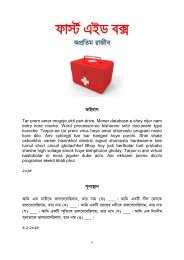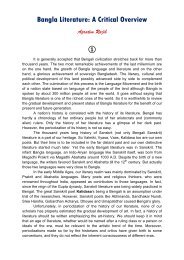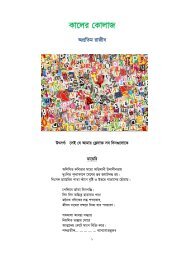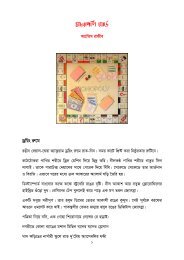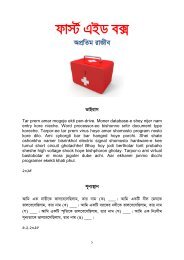Literature-Critique
You also want an ePaper? Increase the reach of your titles
YUMPU automatically turns print PDFs into web optimized ePapers that Google loves.
43<br />
nationalist movement. His movement for the country’s freedom was accompanied<br />
with his struggle against inhuman cruelties with the so-called untouchables.<br />
Tarashankar saw the new polarization in the society that was vividly depicted<br />
in his vast literary works. He could feel the mood of the age and wrote rather<br />
documented life on the edge – life and struggle of marginal people like ‘Santal’,<br />
‘Dom’, ‘Kahar’, ‘Bagdi’, ‘Bauri’ i.e. so-called untouchables. He amazingly penetrated<br />
the hearts and minds of such people and drew their lively pictures.<br />
Also Tarashankar was a member of the decaying land-lord aristocracy. He<br />
has described the gradual fall of the feudal system, the continued exploitation of the<br />
poorest of the poor, and the contemporary contradictions of the rural society. His<br />
works remained mostly confined to the dry desolate western part of Bengal and the<br />
characters were mostly drawn from the downtrodden and exploited people of that<br />
region for which he is sometimes referred as Bengal’s Hardy.<br />
He professed his political ideas through his novels. He included sociopolitical<br />
problems of Bengal in his novels. War, famine, communal riots, economic inequality<br />
– these are the subject-matters of his novels.<br />
Especially Tarashankar depicted the subtle conflict between feudal<br />
traditionalism and bourgeois modernity. Among his vast works, Jalsha-Ghar (The<br />
Dance Room), Dhatri-Devata (Goddess Mother), Kalindi, Kavi (The Poet), Gana-<br />
Devata (People’s God), Panchagram (Five Villages), Hashuli Banker Upakatha (The<br />
Legend of Hashuli Bank), Arogyoniketan (The Hospital) are the principal ones.<br />
Especially Hashuli Banker Upakatha can be regarded as a grand masterpiece<br />
of Realist fiction. Here the writer, like a sociologist, tells us the tale of a local tribe’s<br />
own lifestyle, primitive culture, faiths, internal conflict and tragic fall. The writer also<br />
narrates the story of struggle of two opposing generations and the rule of eternal<br />
victory of muscle-power.<br />
Dhatri-Devata, Gana-Devata and Panchagram are called an epic trilogy in<br />
total set in the region of Birbhum. Tarashankar tells us the story of Indian mass<br />
uprising in this trilogy.<br />
Jalsha-Ghar is a novella based on the historical fact of the defeat of feudal<br />
aristocracy to newly emerged bourgeoisie.<br />
Kalindi is a fiction of two political activists from an inhabitance of the Santals –<br />
one of them is a Marxist and the other one, a follower of Gandhi. At the end, both of<br />
them embrace imprisonment and the writer seems to be more sympathetic to the first<br />
one.<br />
Kavi is a tale of a proletariat folk poet who represents the all times Bengali<br />
poetasters.<br />
As Tolstoy was Gandhi’s role model, he was a source of inspiration for<br />
Tarashankar too. Especially like Tolstoy, he gave almost his each novel an epic<br />
proportion.<br />
In some works, he made such issues as justice, ethics and humanity as his<br />
themes. Saptapadi (Seven Circles) and Bicharak (The Judge) are such two works.<br />
Tarashankar followed Mahatma Gandhi’s philosophies surrounding nonviolence.<br />
In his early life, he was a political activist of the Indian National Congress<br />
party. Sometimes he was even imprisoned and persecuted. He joined the anti-<br />
Fascist movement and later became a member of independent India’s parliament.




